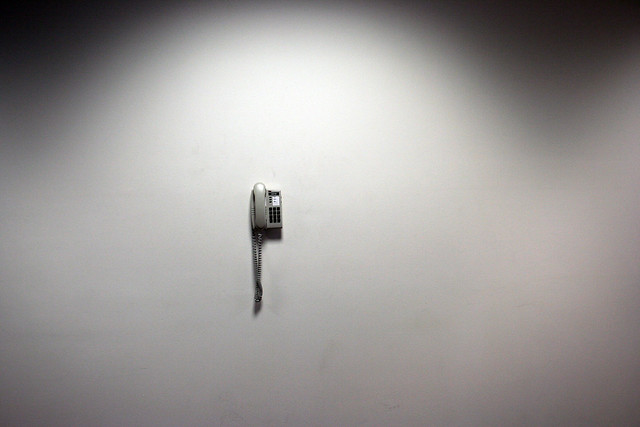While rules like the Rule of Thirds and the Golden Mean have been practiced for a long time and advocated in many articles and books, in real life situations, they can become inhibiting factors.

“Big Guns” captured by Krystian Olszanski.
On average, when photography is done for friends and family, we don’t have much scope for applying these rules. Even in the commercial and industrial photography, the requirements are very much difference and in fact, most situations demand breaking these rules and delivering as per the brief given by the client.
One example is the genre of corporate photography, in which photography assignments are given to professional photographers to shoot the top brass of an organization. All the subjects have to be bang in the middle of the photographs and there is little or no extra scope to apply the rule of thirds.

“Lonely Phone” captured by Sarah Laval.
The main area of application of the rule of thirds is in fine art photography. Fine art photography is the genre of photography in which the photographer has complete freedom to express their creativity as best they think is appropriate to the target audience.
In nature photography, say of animals and birds, getting the subject at any of the four points of ‘interest’ as enumerated in the rule of thirds is not just difficult but also not desirable. Imagine a photograph of an eagle flying in the sky with 80 percent of the photograph filled with empty blue sky and the main subject of the photograph—the eagle in this case—relegated to one of the corners.
One of the best methods to overcome the challenges is to practice breaking it with innovative composition and other photography techniques to highlight the subject and yet not make the photograph contrived. One of the worst practices is to adhere strictly to the rule even at the cost of composition and overall aesthetic appeal of the photograph.
Although aesthetically the photographs may look “balanced” there is always the danger of keeping the main subject of the image way off the intersection line of rule of thirds, relegating the subject to a corner and leaving too much empty space. This results in somewhat awkward looking photographs and leaves a feeling of incompleteness in the overall visual impact of the photograph.
The challenging aspects of the Rule of Thirds have been overcome by all great photography legends, who deliver not only world-class results but also generate great interest in their work from the critics as well as the target audience. The truly great artists transcend boundaries and become legends.
About the Author:
Pashminu Mansukhani is part of an Industrial Photographer service company.
For Further Training, Deal Ending Soon:
Just recently released, The Photography Action Cards, 65 beautifully designed & printable project sheets that will give you over 200 photography assignments covering everything you can imagine. The response has been so big that we asked them to extend their launch sale just a little bit longer for our blog readers, currently 88% off today if you want to try them out.
Each card will retail for $ 5 USD. That means, buying the complete collection individually would cost hundreds. However, for this special early-access offer (to a very select few), you can grab this brand-new training tool for just $ 39! All of it also carries an amazing 365 day happiness guarantee so there is no risk in trying them.
Deal found here: The Photography Action Cards at 88% Off
Go to full article: Rule of Thirds: Breaking it When Necessary
What are your thoughts on this article? Join the discussion on Facebook
PictureCorrect subscribers can also learn more today with our #1 bestseller: The Photography Tutorial eBook
The post Rule of Thirds: Breaking it When Necessary appeared first on PictureCorrect.

